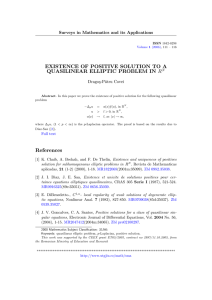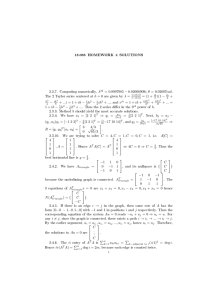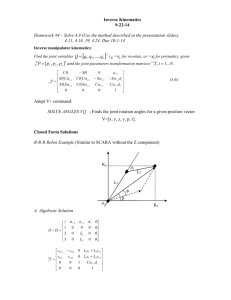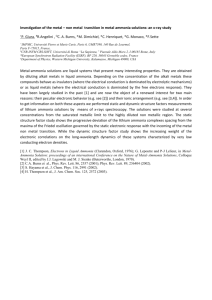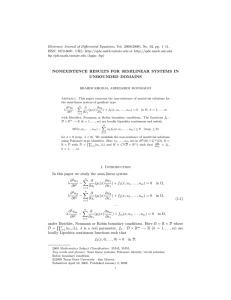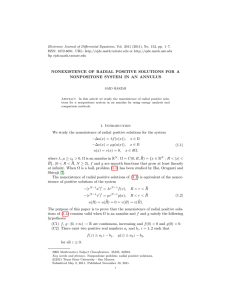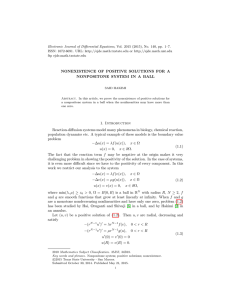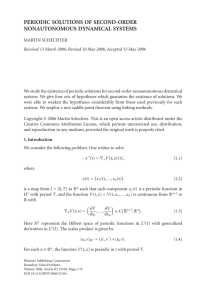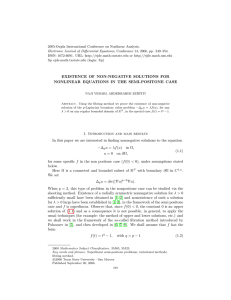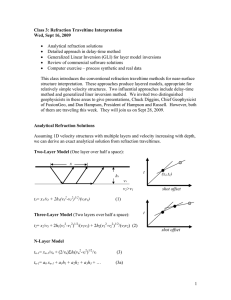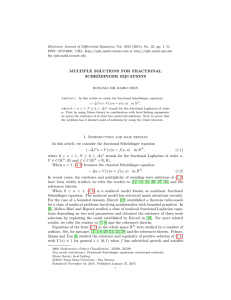Document 10748755
advertisement
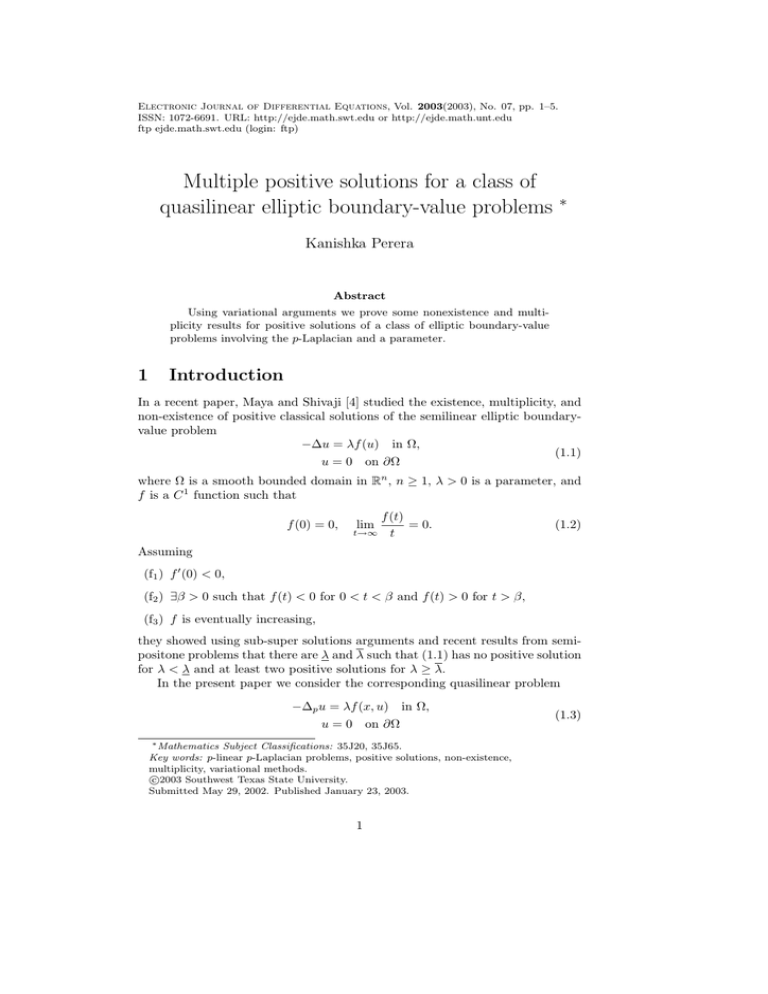
Electronic Journal of Differential Equations, Vol. 2003(2003), No. 07, pp. 1–5. ISSN: 1072-6691. URL: http://ejde.math.swt.edu or http://ejde.math.unt.edu ftp ejde.math.swt.edu (login: ftp) Multiple positive solutions for a class of quasilinear elliptic boundary-value problems ∗ Kanishka Perera Abstract Using variational arguments we prove some nonexistence and multiplicity results for positive solutions of a class of elliptic boundary-value problems involving the p-Laplacian and a parameter. 1 Introduction In a recent paper, Maya and Shivaji [4] studied the existence, multiplicity, and non-existence of positive classical solutions of the semilinear elliptic boundaryvalue problem −∆u = λf (u) in Ω, (1.1) u = 0 on ∂Ω where Ω is a smooth bounded domain in Rn , n ≥ 1, λ > 0 is a parameter, and f is a C 1 function such that f (0) = 0, lim t→∞ f (t) = 0. t (1.2) Assuming (f1 ) f 0 (0) < 0, (f2 ) ∃β > 0 such that f (t) < 0 for 0 < t < β and f (t) > 0 for t > β, (f3 ) f is eventually increasing, they showed using sub-super solutions arguments and recent results from semipositone problems that there are λ and λ such that (1.1) has no positive solution for λ < λ and at least two positive solutions for λ ≥ λ. In the present paper we consider the corresponding quasilinear problem −∆p u = λf (x, u) in Ω, u = 0 on ∂Ω ∗ Mathematics Subject Classifications: 35J20, 35J65. Key words: p-linear p-Laplacian problems, positive solutions, non-existence, multiplicity, variational methods. c 2003 Southwest Texas State University. Submitted May 29, 2002. Published January 23, 2003. 1 (1.3) 2 Multiple positive solutions EJDE–2003/07 where ∆p u = div |∇u|p−2 ∇u is the p-Laplacian, 1 < p < ∞, λ > 0, and f is a Carathéodory function on Ω × [0, ∞) satisfying f (x, 0) = 0, |f (x, t)| ≤ Ctp−1 (1.4) for some constant C > 0. Note that when p = 2 and f is C 1 and satisfies (1.2), the existence of the limits limt→0 f (t)/t = f 0 (0) and limt→∞ f (t)/t imply (1.4). Using variational methods, we shall prove the following theorems. Theorem 1.1. There is a λ such that (1.3) has no positive solution for λ < λ. Rt Theorem 1.2. Set F (x, t) = 0 f (x, s)ds, and assume (F1 ) ∃δ > 0 such that F (x, t) ≤ 0 for 0 ≤ t ≤ δ, (F2 ) ∃t0 > 0 such that F (x, t0 ) > 0, (F3 ) lim t→∞ F (x, t) ≤ 0 uniformly in x. tp Then there is a λ such that (1.3) has at least two positive solutions u1 > u2 for λ ≥ λ. Note that we have substantially relaxed the assumptions in [4] and therefore our results seem to be new even in the semilinear case p = 2. More specifically, we have let f depend on x and dropped the assumption of differentiability in t, and replaced (f1 ), (f2 ), and (f3 ) with the much weaker assumptions (F1 ) and (F2 ) on the primitive F . We emphasize that (F1 ) follows from (f1 ), while (f2 ) and (f3 ) together imply (F2 ), and that we make no monotonicity assumptions. The limit in (F3 ) equals 0 in the p-sublinear case lim t→∞ f (x, t) = 0 uniformly in x, tp−1 (1.5) in particular, in the special case considered in [4]. 2 Proofs of Theorems 1.1 and 1.2 Recall that the first Dirichlet eigenvalue of −∆p is positive and is given by R |∇u|p λ1 = min RΩ (2.1) u6=0 |u|p Ω (see Lindqvist [3]). If (1.3) has a positive solution u, multiplying (1.3) by u, integrating by parts, and using (1.4) gives Z Z Z |∇u|p = λ f (x, u)u ≤ Cλ up , (2.2) Ω Ω and hence λ ≥ λ1 /C by (2.1), proving Theorem 1.1. Ω EJDE–2003/07 Kanishka Perera 3 We will prove Theorem 1.2 using critical point theory. Set f (x, t) = 0 for t < 0, and consider the C 1 functional Z Φλ (u) = |∇u|p − λpF (x, u), u ∈ W01,p (Ω). (2.3) Ω If u is a critical point of Φλ , denoting by u− the negative part of u, Z 0 = (Φ0λ (u), u− ) = |∇u|p−2 ∇u · ∇u− − λf (x, u)u− = ku− kp (2.4) Ω shows that u ≥ 0. Furthermore, u ∈ L∞ (Ω) ∩ C 1 (Ω) by Anane [1] and di Benedetto [2], so it follows from the Harnack inequality (Theorem 1.1 of Trudinger [6]) that either u > 0 or u ≡ 0. Thus, nontrivial critical points of Φλ are positive solutions of (1.3). By (F3 ) and (1.4), there is a constant Cλ > 0 such that λpF (x, t) ≤ λ1 p |t| + Cλ 2 (2.5) and hence Z |∇u|p − Φλ (u) ≥ Ω λ1 p 1 |u| − Cλ ≥ kukp − Cλ µ(Ω) 2 2 (2.6) where µ denotes the Lebesgue measure in Rn , so Φλ is bounded from below and coercive. This yields a global minimizer u1 since Φλ is weakly lower semicontinuous. Lemma 2.1. There is a λ such that inf Φλ < 0, and hence u1 6= 0, for λ ≥ λ. Proof. Taking a sufficiently large compact subset Ω0 of Ω and a function u0 ∈ W01,p (Ω) such that u0 (x) = t0 on Ω0 and 0 ≤ u0 (x) ≤ t0 on Ω \ Ω0 , where t0 is as in (F2 ), we have Z Z F (x, u0 ) ≥ F (x, t0 ) − Ctp0 µ(Ω \ Ω0 ) > 0 (2.7) Ω Ω0 and hence Φλ (u0 ) < 0 for λ large enough. Now fix λ ≥ λ, let f (x, t), t ≤ u1 (x), fe(x, t) = f (x, u (x)), t > u (x), 1 1 Then consider Z e λ (u) = Φ Ω Z and Fe(x, t) = |∇u|p − λpFe(x, u). t fe(x, s)ds. (2.8) 0 (2.9) 4 Multiple positive solutions EJDE–2003/07 e λ , then u ≥ 0 as before, and If u is a critical point of Φ e 0λ (u) − Φ0λ (u1 ), (u − u1 )+ 0= Φ Z = |∇u|p−2 ∇u − |∇u1 |p−2 ∇u1 · ∇(u − u1 )+ Ω − λ fe(x, u) − f (x, u1 ) (u − u1 )+ Z = |∇u|p−2 ∇u − |∇u1 |p−2 ∇u1 · (∇u − ∇u1 ) Zu>u1 ≥ |∇u|p−1 − |∇u1 |p−1 (|∇u| − |∇u1 |) ≥ 0 (2.10) u>u1 implies that u ≤ u1 , so u is a solution of (1.3) in the order interval [0, u1 ]. We e λ (u2 ) > 0 via the mountain-pass lemma, will obtain a critical point u2 with Φ e λ (0) = 0 > Φ e λ (u1 ). which would complete the proof since Φ e λ. Lemma 2.2. The origin is a strict local minimizer of Φ Proof. Setting Ωu = x ∈ Ω : u(x) > min u1 (x), δ , by (2.8) and (F1 ), Fe(x, u(x)) ≤ 0 on Ω \ Ωu , so Z e λ (u) ≥ kukp − λp Φ Fe(x, u). (2.11) Ωu By (1.4), Hölder’s inequality, and Sobolev imbedding, Z Z p Fe(x, u) ≤ C up ≤ Cµ(Ωu )1− q kukp Ωu (2.12) Ωu where q = np/(n − p) if p < n and q > p if p ≥ n, so it suffices to show that µ(Ωu ) → 0 as kuk → 0. Given ε > 0, take a compact subset Ωε of Ω such that µ(Ω \ Ωε ) < ε and let Ωu,ε = Ωu ∩ Ωε . Then Z p kukp ≥ up ≥ cp µ(Ωu,ε ) (2.13) Ωu,ε where c = min min u1 (Ωε ), δ > 0, so µ(Ωu,ε ) → 0. But, since Ωu ⊂ Ωu,ε ∪ (Ω \ Ωε ), µ(Ωu ) < µ(Ωu,ε ) + ε, (2.14) and ε is arbitrary. e λ is also coAn argument similar to the one we used for Φλ shows that Φ e ercive, so every Palais-Smale sequence of Φλ is bounded and hence contains a convergent subsequence as usual. Now the mountain-pass lemma gives a critical e λ at the level point u2 of Φ c := inf max γ∈Γ u∈γ([0,1]) e λ (u) > 0 Φ (2.15) where Γ = γ ∈ C([0, 1], W01,p (Ω)) : γ(0) = 0, γ(1) = u1 is the class of paths joining the origin to u1 (see, e.g., Rabinowitz [5]). EJDE–2003/07 Kanishka Perera 5 References [1] A. Anane. Etude des valeurs propres et de la résonnance pour l’opérateur p-Laplacien. PhD thesis, Université Libre de Bruxelles, 1987. C. R. Acad. Sci. Paris Sér. I Math., 305(16):725–728, 1987. [2] E. di Benedetto. C 1+α local regularity of weak solutions of degenerate elliptic equations. Nonlinear Anal., 7(8):827–850, 1983. [3] P. Lindqvist. On the equation div(|∇u|p−2 ∇u) + λ|u|p−2 u = 0. Proc. Amer. Math. Soc., 109(1):157–164, 1990. Addendum: Proc. Amer. Math. Soc., 116(2):583–584, 1992. [4] C. Maya and R. Shivaji. Multiple positive solutions for a class of semilinear elliptic boundary value problems. Nonlinear Anal., 38(4, Ser. A: Theory Methods):497–504, 1999. [5] P. H. Rabinowitz. Minimax methods in critical point theory with applications to differential equations. Published for the Conference Board of the Mathematical Sciences, Washington, DC, 1986. [6] N. Trudinger. On Harnack type inequalities and their application to quasilinear elliptic equations. Comm. Pure Appl. Math., 20:721–747, 1967. Kanishka Perera Department of Mathematical Sciences Florida Institute of Technology Melbourne, FL 32901, USA e-mail: kperera@fit.edu http://my.fit.edu/∼kperera/
